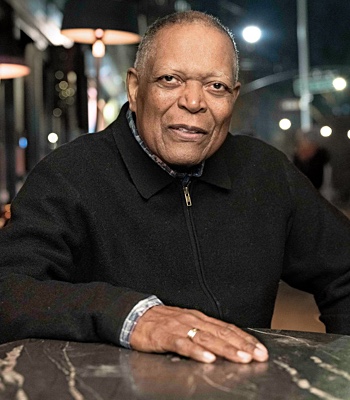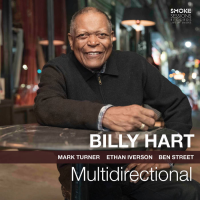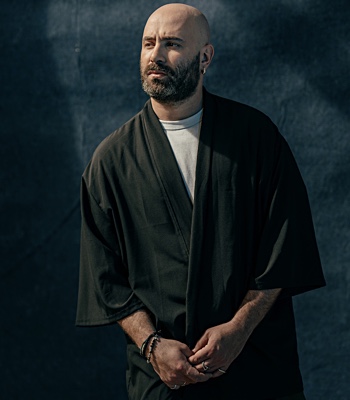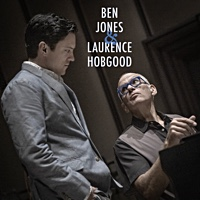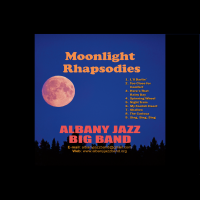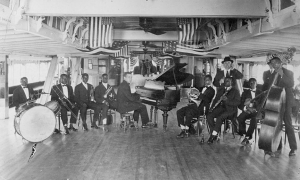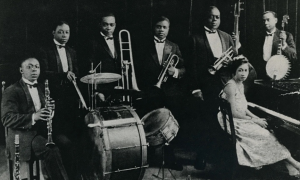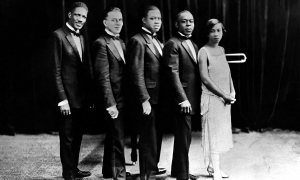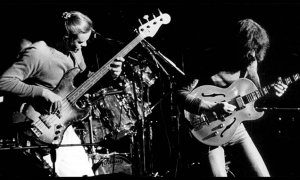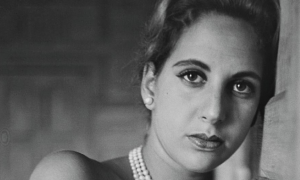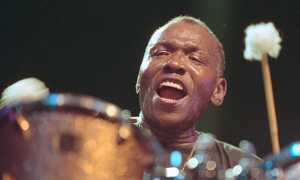Home » Jazz Articles » Backstories » The Black Entrepreneurs of Early Jazz
The Black Entrepreneurs of Early Jazz

Courtesy AI
Harry Pace saw that there was profit to be made by Black people producing and distributing music for Black people.
—Willie Ruff, musician and professor emeritus, Yale University
In the early 1920s, mainstream American record labels, dominated by white executives, largely avoided recording Black musicians, fearing backlash from white audiences. However, a growing demand for Black music—encompassing blues, jazz, gospel, and ragtime—created an opportunity for enterprising African American and white entrepreneurs to establish "race records," a segregated yet vital market that brought Black artists to national prominence. While some labels were clandestinely backed by major companies, independent Black-owned labels and producers played a crucial role in shaping the industry.
The most important figure in the establishment of the race records industry was Harry Pace. Pace (1884—1943) was born in Covington, Georgia. His father was a blacksmith and a former slave who died when Pace was young. His mother worked as a cook to support the family. Despite the enormous challenges faced by Black families in the post-Reconstruction South, Pace displayed exceptional intellectual promise from a young age. He attended Atlanta University (now Clark Atlanta University), where he studied business and worked under the tutelage of scholar and activist W.E.B. Du Bois, then a professor at the institution. This relationship proved to be influential. Du Bois' philosophy of the "Talented Tenth"—the idea that a highly educated, cultured class of Black leaders was essential for advancing the race—shaped Pace's ambitions and business ethos. He graduated as valedictorian of his class in 1903.
Early Business Ventures
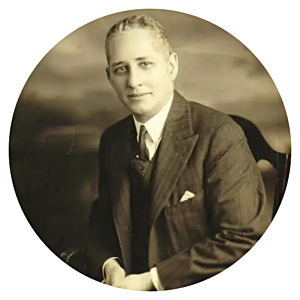 After graduation, Pace moved to Memphis, Tennessee, and entered the business world. He worked in various capacities, including as a newspaper publisher and an insurance agent. His most significant early partnership was formed with the "Father of the Blues," W.C. Handy. In 1912, Pace and Handy founded the Pace & Handy Music Company in Memphis, later moving it to New York City's thriving Tin Pan Alley district in 1918. Pace served as the business manager and lyricist, while Handy composed the music. The company was highly successful, publishing some of the most iconic songs of the era, including Handy's "St. Louis Blues." Pace's business savvy was instrumental in the firm's success, ensuring that Black composers received proper copyrights and royalties, a radical concept at a time when white publishers often exploited Black artists.
After graduation, Pace moved to Memphis, Tennessee, and entered the business world. He worked in various capacities, including as a newspaper publisher and an insurance agent. His most significant early partnership was formed with the "Father of the Blues," W.C. Handy. In 1912, Pace and Handy founded the Pace & Handy Music Company in Memphis, later moving it to New York City's thriving Tin Pan Alley district in 1918. Pace served as the business manager and lyricist, while Handy composed the music. The company was highly successful, publishing some of the most iconic songs of the era, including Handy's "St. Louis Blues." Pace's business savvy was instrumental in the firm's success, ensuring that Black composers received proper copyrights and royalties, a radical concept at a time when white publishers often exploited Black artists. Pace grew frustrated with the music industry's pervasive racism. White recording companies and publishers were primarily interested in marketing race records that depicted African Americans in a stereotypical, often derogatory manner. Pace envisioned a company that would enable Black artists to record with dignity and present a more comprehensive, refined picture of Black talent.
The Founding of Black Swan Records (1921-1924)
In March 1921, Pace dissolved his partnership with Handy and founded the Pace Phonograph Corporation, launching its record label, Black Swan Records. The label was named after the celebrated 19th-century Black opera singer, Elizabeth Taylor Greenfield, known as the "Black Swan." This name was a direct statement of intent—i.e., to showcase the high-class, cultured talent of the Black community. Pace assembled an impressive board of directors, including W.E.B. Du Bois and Vermont Senator Porter H. Dale, to lend credibility and help secure investment. The company's motto was "The Only Genuine Race Record. Others Are Only Passing for Colored." This was a swipe at white-owned labels like Okeh and Columbia that were beginning to see the profit in "race records" but were not owned by African Americans.Pace's Artistic Vision
Pace's initial goal was to record classical, operatic, and concert music by Black performers to challenge stereotypes. The label's first hit was "Down Home Blues" by Ethel Waters, which sold an estimated 100,000 copies in six months. While Waters was a blues singer, her style was considered more sophisticated and polished than the rural "country blues." The label's classical music star was Caterina Jarboro, a soprano who would later have a celebrated career in opera in Europe. Black Swan also employed Fletcher Henderson as its house pianist and musical director, giving the legendary bandleader his first major break. Henderson also led the label's touring ensemble, The Black Swan Troubadours, which featured Ethel Waters.The Demise of Black Swan Records
Despite early success, Black Swan faced immense challenges. Rapid expansion, including the construction of its own pressing plant, put a strain on the company's finances. Additionally, major white-owned labels, such as Victor and Columbia, began aggressively signing Black artists, offering them better distribution and promotion. The record-buying public, both Black and white, showed a stronger preference for blues and jazz over the classical music Pace wanted to promote. By late 1923, the company was in a state of serious debt. In April 1924, Pace was forced to sell Black Swan's assets to the Paramount Records label for a fraction of its worth. Though short-lived, its impact was seismic. It proved there was a vast market for records by Black artists and paved the way for every Black-owned entertainment company that followed. After the collapse of Black Swan, Pace did not disappear from business. He returned to the field he knew well: insurance. He moved to Chicago and founded the Northeastern Life Insurance Company, which became one of the most successful Black-owned businesses in the North. He used the lessons learned from his recording venture to build a stable and prosperous company that served the African American community. He remained a respected figure in Chicago's business and civic circles until his death from complications related to bronchitis in 1943, at the age of 59.Pace was a central figure in the "Black Metropolis" movement, building successful enterprises that created jobs and served the community within a segregated economy. His ambition to utilize commerce as a means of challenging racial stereotypes and promoting a dignified image of Black America was aligned with the cultural objectives of the Harlem Renaissance. His ear for talent launched or accelerated the careers of many session musicians.
Other Entrepreneurs
Along with Pace and W.C. Handy, several other Black musician-entrepreneurs pushed the envelope in the pre-jazz era. An enterprising pianist and songwriter, Perry Bradford (1893—1970) convinced Okeh Records to record Mamie Smith's "Crazy Blues" (1920), the first blues record by a Black artist. Bradford was born in Montgomery, Alabama. His family moved to Atlanta, Georgia, while he was young, and it was there that he began his show business career. By his early teens, he was performing as a song-and-dance man in minstrel shows and traveling vaudeville circuits. He later formed his own troupe, "Bradford's Musical Prodigies," which toured extensively throughout the South and Midwest.Traveling the Theatre Owners Booking Association circuit was grueling but provided Bradford with an invaluable education in the entertainment business, from promotion and booking to understanding audience tastes. He was not just a performer—he was a showrunner. By 1910, Bradford had settled in Chicago and he moved to New York City in 1917. It was in New York that he began to focus on songwriting and publishing, recognizing the potential financial rewards. The Mamie Smith recording sold more than 75,000 copies in its first month after release, revealing an untapped market for Black music. Bradford continued producing race records, working with artists like Alberta Hunter. His persistence forced major labels to acknowledge the commercial potential of Black musicians.
Clarence Williams (1893—1965) was not a well-known performer, although he was a skilled pianist. Instead, his impact on early jazz and blues stems from his multifaceted role as a composer, publisher, producer, talent scout, and record company executive. In an era when Black artists were systematically exploited, Williams used his sharp business acumen to create opportunities, shape the sound of recorded jazz, and ensure that African-American music reached a national audience, all while protecting his own financial interests.
Born just south of Baton Rouge, Williams was surrounded by music from a young age. He was of Creole descent, and his family reportedly owned and operated a hotel that hosted traveling musicians. Blind in one eye from a childhood accident, he learned to play the piano by ear and was influenced by the ragtime and early jazz sounds of New Orleans. As a young man, he left home to become an itinerant musician, a common path for Black artists in the South. He worked in tent shows and honky-tonks, often with the emerging blues singers of the day. A prolific composer, Williams either wrote or purchased the rights to a stunning number of songs that would become jazz and blues standards. His most famous compositions include "Baby, Won't You Please Come Home" (1919) and "Everybody Loves My Baby" (1924). He produced early recordings by Louis Armstrong, Sidney Bechet, and Bessie Smith. He co-founded Clarence Williams Music Publishing, securing royalties for Black artists. Williams helped bridge the gap between jazz and blues, bringing those genres into the mainstream recording industry.
The Legacy of Race Records
The story of race records is a pivotal chapter in American cultural history, marking the beginning of the commercial recording industry's recognition of Black consumers and artists, while also being deeply entrenched in the era's segregation. Label executives advertised in Black-owned newspapers, such as the Chicago Defender, which played a crucial role in promoting new releases and generating demand nationwide. The Great Depression of the 1930s had a profound impact on the entire music industry. Major labels significantly scaled back their race series. However, this created an opening for a new wave of small, independent labels. Companies like Atlantic, Chess, and Specialty emerged in the late 1940s. These labels were more agile and often more connected to the evolving sounds within Black communities. They began to move away from the term "race," which was increasingly seen as a pejorative holdover from a segregated past.References
- Abdur-Rahman, Aliyyah I. "The Strange Career of Harry Pace: Black Entrepreneurship and the Color Line." American Quarterly, vol. 68, no. 3, 2016, pp. 653—79.
- Brooks, Tim. Lost Sounds: Blacks and the Birth of the Recording Industry, 1890-1919. University of Illinois Press, 2004.
- McGrath, Bob. The R&B Indies: Volume 1. Eyeball Productions, 2000.
- Bradford, Perry. Born with the Blues: Perry Bradford's Own Story. Oak Publications, 1965.
- Kenney, William Howland. Jazz on the River. University of Chicago Press, 2005.
- Handy, W.C. Father of the Blues: An Autobiography. Da Capo Press, 1991.
Tags
PREVIOUS / NEXT
Support All About Jazz
 All About Jazz has been a pillar of jazz since 1995, championing it as an art form and, more importantly, supporting the musicians who make it. Our enduring commitment has made "AAJ" one of the most culturally important websites of its kind, read by hundreds of thousands of fans, musicians and industry figures every month.
All About Jazz has been a pillar of jazz since 1995, championing it as an art form and, more importantly, supporting the musicians who make it. Our enduring commitment has made "AAJ" one of the most culturally important websites of its kind, read by hundreds of thousands of fans, musicians and industry figures every month.




